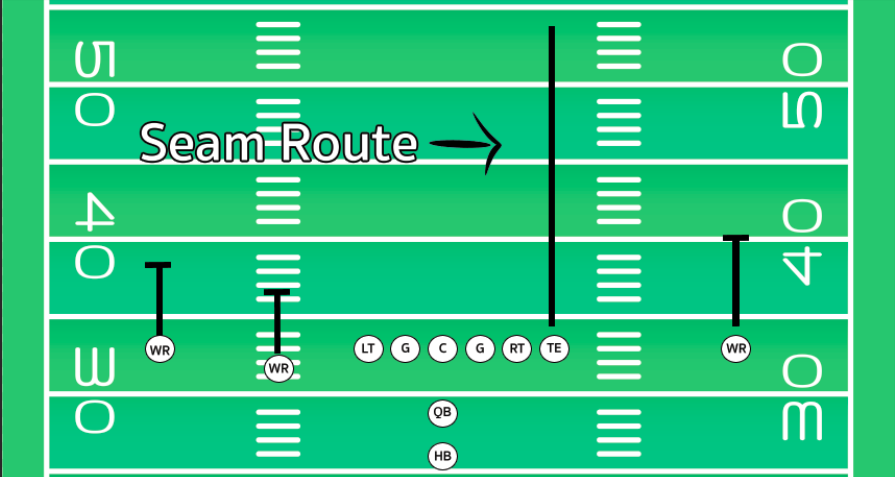A seam route in football is the same as a go/fly route but it is run into an area between two defenders.
The reason this route is referred to as a seam route is that it takes place on the seam of two different coverages. A seam refers to where two things come together such as a seam on a pair of jeans.
By running a seam route the receiver will run right on the seam of the two coverages. This can allow the receiver to be left unnoticed by the defender. Or it can cause a defender to move to the edge of his zone ultimately getting a teammate open.
On a seam route a receiver is going to run the route exactly as you would run a go route. There are no cuts or breaks involved in this route the receiver must simply sprint upfield at full speed.
A seam route is run in the middle of the field. Usually, the receiver will be running on the seam in between the linebacker and the safety or the cornerback and the safety.
Due to the location of the route it is almost always run by tight ends or slot receivers.
Tight ends and slot receivers also tend to run other short routes such as outs or even check-down routes in the flat.
Key Factors Of A Seam Route
Now that you understand what a seam route is in football it’s time to learn a little more about them. Below we are going to break down some of the key factors that you should know about these routes in football.
Forcing A Decision
One of the main reasons the seam route works in football is because it forces defenders into a tough decision. Since the route is going to be run on the seam of two coverage the defense is going to have to communicate effectively in order to neutralize the route.
If neither defender picks up the receiver he will be able to run freely down the middle of the field. If both try to pick up the receiver than one of his teammates is likely to be left open.
This forces the defense to figure out which defender is going to cover the player runnign the seam route.
If the defenders are able to communicate their assignments on this play it is likely the receiver will get open.
Keep Your Eyes On The QB
As the receiver on a seam route you want to be sure to keep your eyes on the quarterback. Due to a lack of cut the quarterback can effectively throw the ball to a receiver on seam route at any point.
So long as the receiver is ready for the pass the quarterback can throw his way.
Most seam routes are thrown a second or two after the ball is snapped. But if the quarterback is under pressure you may find the ball will come out oa little quicker
To compensate for situations like this receivers need to be sure to get your head around quickly. This the quarterback can target them at any point during the play.
Be Ready For A Catch In Traffic
Another major factor of the seam route is that this catch is likely to come with some contact. A seam route is run right in the middle of the field. So after the receiver makes the catch he/she can expect to be hit.
Additionally, seam routes are often covered by linebackers following the tight end or slot receiver downfield. These players are not going to have their head turned towards the quarterback.
Since they can’t see the pass the quarterback will often throw the ball over top of defenders in this situation.
They will not be able to see the ball but the receiver will often be forced to make a catch in traffic in these sorts of situations.
The safeties are also sitting over the top of this route. Meaning after catching it they will be coming downhill in the direction of the receiver.
If a player is running a seam route it is important they are able to take a hit and make contested grabs.
That’s all for seam routes, other verticle receiver routes include go routes and the often-used post route.

